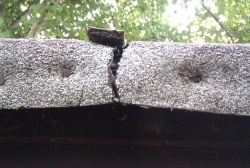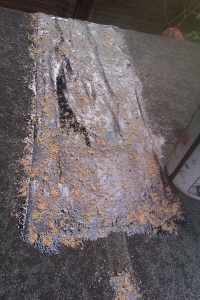Felt roof repair
This article addresses patch repairs of felt covered roofs.
Patch repair is doomed in the sense that once felt begins to go, it usually doesn't last well whatever you do. However its sometimes possible to get extra years before refelting is needed, usually when the felt is mostly in ok condition.
Patching
Make the surface onto which a new felt patch goes fairly even, felt always needs support under it. Clean any muck off. Better durability is gained by filling any cracks, holes etc with a bitumen based mix to provide an even-ish base. Apply a layer of bitumen adhesive/paint to the area to be patched and apply the felt patch. Patches should have plenty of overlap to help keep them there. Paint more bitumen around and over the edges for maximum adhesion. Adding clout nails is optional - they attach felt well, but also pierce it.
Gloop
Various gloops can be bought for filling splits in roofing felt. Sometimes they work, but often not. Buyers are prone to being optimistic.
When applying gloops, ensure water everywhere on the roof has a free run off the roof. Despite the optimism of some roof repairers, water doesn't run uphill! Failures are much more likely where water lingers.
Deck rot
Patch repairs are much more likely to survive if the deck underneath is still solid, firm and even. Otherwise patching is likely to be short lived. If you're determined to try and patch a holed deck, sliding a bit of thin rigid sheet such as slate under the felt and over the deck hole can help. Bond it to the felt with bitumen. If the damage is very narrow, gloop may be enough to fill it.
Home made felt patching
Basic roofing felt is only rag felt plus bitumen, plus a little sand on top. This is easy enough to replicate using scrap material. Follow the method in 'patching' above, but use cloth in lieu of roof felt, painting it all over with bitumen once applied. A stippling brush action helps avoid the cloth moving.
Once done, throw sand onto it. This reduces heat absorption, avoiding the risk of it melting on a particuarly hot day. It also toughens up the surface to a degree.
Home made gloop
Filler for roof cracks etc is simple to make, using sand plus a little bitumen adhesive/paint. Gloop can't be counted on to repair a crack on its own, but may be used to create an even bed onto which new felt may be laid. It also acts as a secondary barrier to water sometimes.

